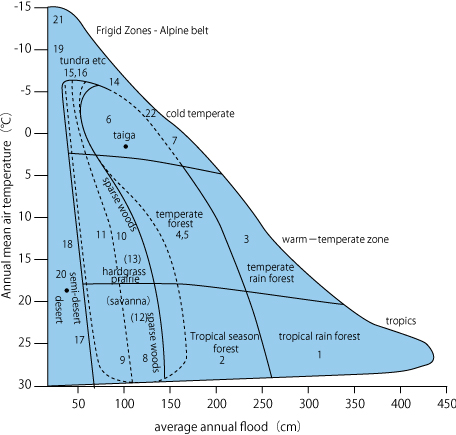Peoples on Cubic Earth Living with Nature
On the cubic Earth, people “cubicites” inhabiting in the sea are assumed to be the top of ecosystem. Assuming that the people on the cubic Earth mainly depend on fish produced in the upwelling area and each people eats 5 kg (fresh weight) of fish every day, about 20 million tons of fish, about 30% of fish produced in the upwelling area, is consumed every year by 10 million people. Then people on the cubic Earth can live sustainably with a surplus.
Here we assume that the people on the cubic Earth have challenged agriculture on land and expanded their food habit from protein rich marine products to starch rich terrestrial crops. Namely they expand their food habit for using grains, vegetables and fruits. They opened the farm ground in the habitable zone. Species which they use for agriculture are expected to find in the tropical rain and seasonal forests, and to obtain suitable strains by selective breeding. According to the consumption of wheat, vegetable and fruits of the people on the Earth, land area to produce necessary foods for 10 million people could be about 5,000 km2 for wheat and vegetable & fruits, respectively, namely 10,000 km2 in total. This is about 5% of the habitable zone, and is expected for supporting the sustainable agriculture.
On the cubic Earth, it is assumed that the people at the top of the ecosystem, having developed science and technology than us on the Earth, is the animal invaded firstly to land from the sea. Although we are now giving 2--3 times of environmental stress to the entire Earth, the environmental stress on the cubic Earth is set as 1/20--1/3.
| Upwelling castle | Coast castle | Ocean castle | |
|---|---|---|---|
| Square measure(10,000km2) | 9 | 18 | 893 |
| Production of plants(mgC/m2/year) | 300,000 | 100,000 | 50,000 |
| The number of trophic levels | 1.5 | 3 | 5 |
| The number of trophic levels | 20 | 15 | 10 |
| Production of fish(mgC/m2/year) | 36,000 | 340 | 0.5 |
| Production of fish(103tf/year) | 64,800 | 1,220 | 89 |
Extra lines in Right before 17 in Left (File A.txt; Line 17; File b.txt; Line 17)

Strange Shaped Vegetables
Tropical rain and seasonal forests are expected to be developed along the seaside of habitable zone and there occurs grass land of Lomas flower and tumble-weed away from the forest. The Lomas flower collects water from air by the leaf, absorbs nutrients by roots and grows using solar radiation. Tumble-weed collects water from air and soil surface during rolling, obtains nutrients from sea water splash near the coast, grows using solar radiation, and disperses the nutrients around the habitable zone when they are decomposed.
Terrestrial ecosystem is assumed to be composed by only 2 groups of organisms such as plants and decomposers, and be no animal as consumer. Namely the matter cycle on the terrestrial ecosystem on the cubic Earth is expected to be carried out solely by plants as the producer of organic matter and microorganisms as the decomposer. This is similar as the forest on the Earth where the effects of animals are extremely limited.



